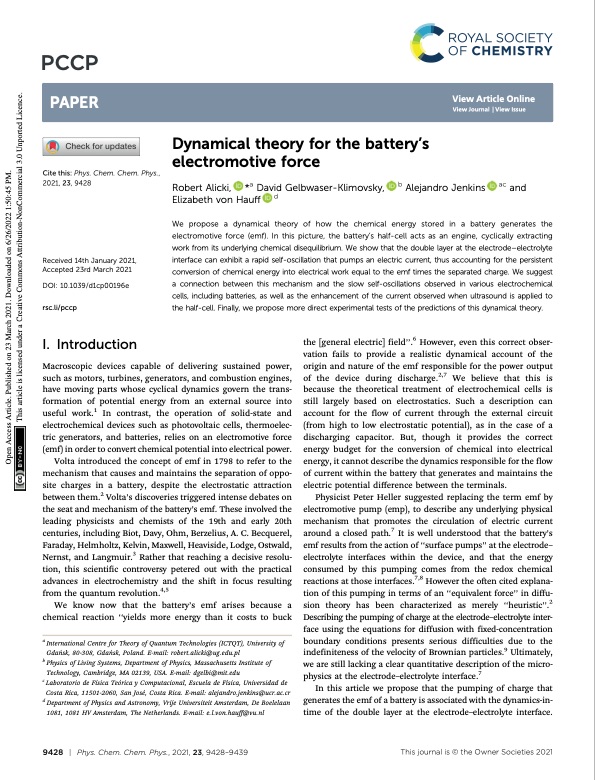
PDF Publication Title:
Text from PDF Page: 001
PCCP PAPER Cite this: Phys. Chem. Chem. Phys., 2021, 23, 9428 Received 14th January 2021, Accepted 23rd March 2021 DOI: 10.1039/d1cp00196e rsc.li/pccp I. Introduction Macroscopic devices capable of delivering sustained power, such as motors, turbines, generators, and combustion engines, have moving parts whose cyclical dynamics govern the trans- formation of potential energy from an external source into useful work.1 In contrast, the operation of solid-state and electrochemical devices such as photovoltaic cells, thermoelec- tric generators, and batteries, relies on an electromotive force (emf) in order to convert chemical potential into electrical power. Volta introduced the concept of emf in 1798 to refer to the mechanism that causes and maintains the separation of oppo- site charges in a battery, despite the electrostatic attraction between them.2 Volta’s discoveries triggered intense debates on the seat and mechanism of the battery’s emf. These involved the leading physicists and chemists of the 19th and early 20th centuries, including Biot, Davy, Ohm, Berzelius, A. C. Becquerel, Faraday, Helmholtz, Kelvin, Maxwell, Heaviside, Lodge, Ostwald, Nernst, and Langmuir.3 Rather that reaching a decisive resolu- tion, this scientific controversy petered out with the practical advances in electrochemistry and the shift in focus resulting from the quantum revolution.4,5 We know now that the battery’s emf arises because a chemical reaction ‘‘yields more energy than it costs to buck a International Centre for Theory of Quantum Technologies (ICTQT), University of Gdan ́sk, 80-308, Gdan ́sk, Poland. E-mail: robert.alicki@ug.edu.pl b Physics of Living Systems, Department of Physics, Massachusetts Institute of Technology, Cambridge, MA 02139, USA. E-mail: dgelbi@mit.edu c Laboratorio de F ́ısica Teo ́rica y Computacional, Escuela de F ́ısica, Universidad de Costa Rica, 11501-2060, San Jos ́e, Costa Rica. E-mail: alejandro.jenkins@ucr.ac.cr d Department of Physics and Astronomy, Vrije Universiteit Amsterdam, De Boelelaan 1081, 1081 HV Amsterdam, The Netherlands. E-mail: e.l.von.hauff@vu.nl View Article Online View Journal | View Issue Dynamical theory for the battery’s electromotive force Robert Alicki, *a David Gelbwaser-Klimovsky, b Alejandro Jenkins ac and d We propose a dynamical theory of how the chemical energy stored in a battery generates the electromotive force (emf). In this picture, the battery’s half-cell acts as an engine, cyclically extracting work from its underlying chemical disequilibrium. We show that the double layer at the electrode–electrolyte interface can exhibit a rapid self-oscillation that pumps an electric current, thus accounting for the persistent conversion of chemical energy into electrical work equal to the emf times the separated charge. We suggest a connection between this mechanism and the slow self-oscillations observed in various electrochemical cells, including batteries, as well as the enhancement of the current observed when ultrasound is applied to the half-cell. Finally, we propose more direct experimental tests of the predictions of this dynamical theory. Elizabeth von Hauff the [general electric] field’’.6 However, even this correct obser- vation fails to provide a realistic dynamical account of the origin and nature of the emf responsible for the power output of the device during discharge.2,7 We believe that this is because the theoretical treatment of electrochemical cells is still largely based on electrostatics. Such a description can account for the flow of current through the external circuit (from high to low electrostatic potential), as in the case of a discharging capacitor. But, though it provides the correct energy budget for the conversion of chemical into electrical energy, it cannot describe the dynamics responsible for the flow of current within the battery that generates and maintains the electric potential difference between the terminals. Physicist Peter Heller suggested replacing the term emf by electromotive pump (emp), to describe any underlying physical mechanism that promotes the circulation of electric current around a closed path.7 It is well understood that the battery’s emf results from the action of ‘‘surface pumps’’ at the electrode– electrolyte interfaces within the device, and that the energy consumed by this pumping comes from the redox chemical reactions at those interfaces.7,8 However the often cited explana- tion of this pumping in terms of an ‘‘equivalent force’’ in diffu- sion theory has been characterized as merely ‘‘heuristic’’.2 Describing the pumping of charge at the electrode–electrolyte inter- face using the equations for diffusion with fixed-concentration boundary conditions presents serious difficulties due to the indefiniteness of the velocity of Brownian particles.9 Ultimately, we are still lacking a clear quantitative description of the micro- physics at the electrode–electrolyte interface.7 In this article we propose that the pumping of charge that generates the emf of a battery is associated with the dynamics-in- time of the double layer at the electrode–electrolyte interface. 9428 | Phys. Chem. Chem. Phys., 2021, 23, 9428–9439 This journal is © the Owner Societies 2021 Open Access Article. Published on 23 March 2021. Downloaded on 6/26/2022 1:50:45 PM. This article is licensed under a Creative Commons Attribution-NonCommercial 3.0 Unported Licence.PDF Image | Dynamic theory battery electromotive force

PDF Search Title:
Dynamic theory battery electromotive forceOriginal File Name Searched:
d1cp00196e.pdfDIY PDF Search: Google It | Yahoo | Bing
Sulfur Deposition on Carbon Nanofibers using Supercritical CO2 Sulfur Deposition on Carbon Nanofibers using Supercritical CO2. Gamma sulfur also known as mother of pearl sulfur and nacreous sulfur... More Info
CO2 Organic Rankine Cycle Experimenter Platform The supercritical CO2 phase change system is both a heat pump and organic rankine cycle which can be used for those purposes and as a supercritical extractor for advanced subcritical and supercritical extraction technology. Uses include producing nanoparticles, precious metal CO2 extraction, lithium battery recycling, and other applications... More Info
| CONTACT TEL: 608-238-6001 Email: greg@infinityturbine.com | RSS | AMP |